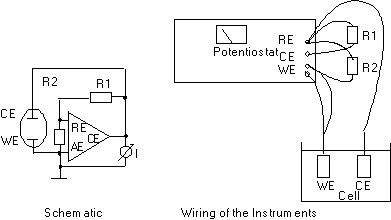


Potentiostats can be used as controlled precision voltage sources. To use this mode, you can - for low voltages - simply connect the counter electrode terminal to the reference electrode terminal. The potential that is fed into the control input (or set by the internal voltage source) now controls directly the voltage of the counter electrode. The maximum current is limited by the set current range, and by the power of the potentiostat, i.e. a 1 A - Potentiostat can control voltages exactly until 1 A of current are reached. If you want to apply voltages beyond the range of the control voltage, you have to insert a potentiometric divider which increases the voltage amplification of the potentiostat. Fig. 2 shows the correct wiring. The two resistors R1 and R2 are calculated from the ration between maximum control voltage and maximum output voltage. Let the potentiostat's output voltage be max. 25 V, and the internal control source have max. 1 V, then
(R1 + R2) / R2 = 25 / 1.
The total resistance should be in the order of some kilo - Ohms to some hundred kilo - Ohms. Use 24 kOhm for R1 and 1 kOhm for R2 as a quite convenient pair here. Now, any voltage applied at the control input or set by the internal control source is amplified by 25 and fed to the CE terminal. 
Fig. 2: Potentiostat as controlled voltage source
Bank Elektronik -
Intelligent Controls GmbH
Hubertusstr. 38
D-35415 Pohlheim
Tel. +49 - 6403 - 60 98 60
Fax +49 - 6403 - 60 98 622
e-Mail: info [at] bank-ic.de